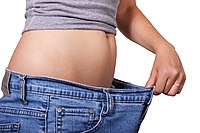
Photo from wikipedia
Abstract Background Obesity has been implicated in impaired salivary secretion. This study aimed at evaluating the influence of diet-induced obesity on salivary secretion and how re-feeding with normal diet would… Click to show full abstract
Abstract Background Obesity has been implicated in impaired salivary secretion. This study aimed at evaluating the influence of diet-induced obesity on salivary secretion and how re-feeding with normal diet would affect changes in salivary secretion associated with diet-induced obesity. Methods Weaning rats weighing 55–65 g were randomly divided into three groups (control, diet-induced obese, re-fed obese) of seven rats each. The diet-induced obese group was fed a high-fat diet for 15 weeks, whereas the re-fed obese group received normal diet for another 15 weeks following the 15 weeks of high-fat diet. After treatment, blood and stimulated saliva samples were collected for the analyses of total protein, electrolytes, amylase, Immunoglobulin A (IgA), leptin and ghrelin. Tissue total protein, nitric oxide level, expressions of Na+/K+-ATPase, muscarinic (M3) receptor and aquaporin 5 in the submandibular glands were determined. Data were presented as mean±SEM and compared using independent student t-test and ANOVA with Tukey’s post-hoc test. Results Results indicated increases in the levels of salivary calcium, phosphate, bicarbonate and leptin, whereas the levels of salivary amylase and ghrelin showed reduction in the obese group compared with the control. Most of these changes were reversed in the re-fed obese group. There were no significant differences in salivary lag time, flow rate, levels of tissue total protein, nitric oxide and the relative expressions of M3 receptor, Na++/K+-ATPase and aquaporin 5 in the submandibular glands between the obese and control groups. Conclusions Diet-induced obesity lead to some changes in salivary factors which were reversed by returning to normal diet.
Journal Title: Journal of Basic and Clinical Physiology and Pharmacology
Year Published: 2018
Link to full text (if available)
Share on Social Media: Sign Up to like & get
recommendations!